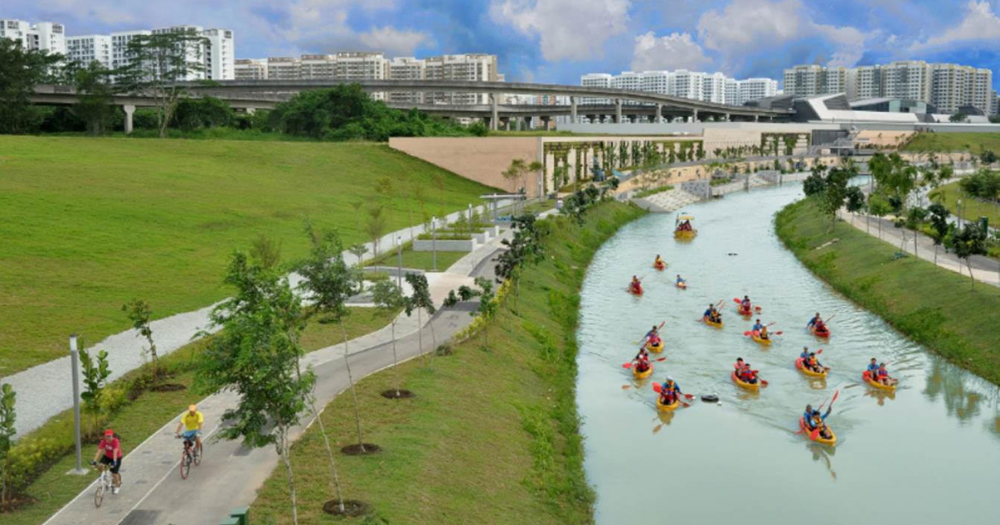Punggol is the first Eco Town in Singapore.
Since 2010, the young town has served as a “living laboratory” where new ideas and technologies are being tested in Punggol before being rolled out to the rest of Singapore.
The Housing and Development Board (HDB) has provided an update on the development of Punggol as a smart and sustainable town over the past decade.
To have possibly the world’s densest cycling network
Punggol will have an extensive 50km cycling network when the town is fully completed in the next decade or so, HDB said.
The town currently also has dual bicycle racks installed at blocks for easier storage of bicycles.
Once the cycling network is completed, Punggol could become the world’s densest cycling network with 5.2km of cycling network per 1km2 of town area.
This exceeds the current world’s densest cycling network in Helsinki, the capital of Finland, which has 4.7km cycling network per 1km2 of city area.
Progress made in driving sustainability in Punggol
Besides an extensive cycling network, significant progress was made in driving sustainability in Punggol, particularly in areas of energy consumption as well as water and waste management.
Compared to 2010, household energy consumption has reduced by 18.8 per cent in 2018, for example. This translates to an annual energy saving that is equivalent to the annual energy use of 17, 200 four-room flats as well as a reduction of carbon emissions that is equivalent to the carbon sequestration of 826,000 trees.
In terms of waste management, HDB has also observed a significant load of recyclables collected in Punggol. The amount of recyclables collected from Punggol is estimated to be at 1,285 tonnes per year. That is about the weight of 89 double decker buses.
All started from eco-precinct Treelodge@Punggol
A number of sustainable ideas and technologies were tested at Treelodge@Punggol back in 2010, HDB’s first public housing development with eco-friendly features.
Features that were successfully tested at Treelodge@Punggol were then introduced to the new public housing projects in Punggol from 2011 and they later became part of a standard suite of eco-features in all new HDB projects.
Here are some examples of the eco-features implemented in Treelodge@Punggol:
Community garden, vertical greenery & green roofs
Vertical greening and green roofs were first introduced to the seven residential blocks in Treelodge@Punggol to cool the environment.
In addition, greenery was introduced to the roof of the car park to create a quiet living environment, as the soft organic surfaces of greenery help to absorb noise from the surroundings.
A part of the car park's roof was also set aside as a community garden to encourage residents’ gardening activities.
Energy efficiency
The HDB flats at Treelodge@Punggol were the first to have solar photovoltaic (PV) panels on the roofs.
The energy generated from the solar panels is used to power common services in the blocks, such as LED lighting in lifts and common areas.
Since then, 169 blocks in Punggol have been fitted with solar panels, while installation works at another 300 blocks are in progress under the SolarNova programme.
Thermal comfort
Another design feature which helps to reduce energy usage and improve thermal comfort is the strategic orientation of blocks at Treelodge@Punggol so that windows would face the prevailing North-Eastern winds.
This allows for less heat from the sun entering homes and improves natural lighting and ventilation.
To cool the blocks at the Treelodge@Punggol development, cool walls with enhanced thermal insulation were also incorporated into the design of the buildings.
Simulation tools were also used to plan Treelodge@Punggol to optimise environmental factors such as identifying the hotspots that need greenery to cool down the temperature, well-shaded spots to install playgrounds and fitness centres and areas with abundant of sunlight to install solar panels.
Such tools were used to plan the Bidadari housing project later.
Water and waste management
To reduce water consumption, Treelodge@Punggol uses a rainwater collection system that is suitable for Singapore’s tropical climate and high rainfall.
The rainwater harvesting system collects rainwater which is used for common corridor washing and to water plants in public spaces.
Centralised refuse chutes for recyclables were also installed at each block to trial if providing a convenient method would increase recycling rate in the community.
We deliver more stories to you on LinkedIn
Top image by HDB
If you like what you read, follow us on Facebook, Instagram, Twitter and Telegram to get the latest updates.
